Five CHSU-COM Research Projects Featured at 2025 Western Medical Research Conference
January 30, 2025
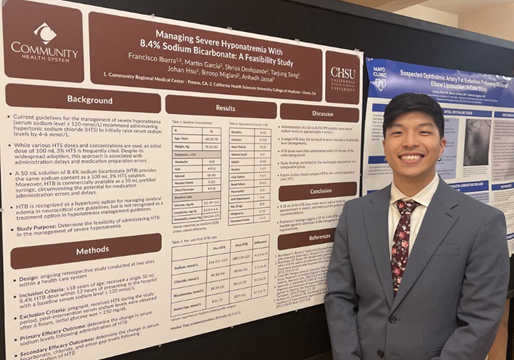
Written by Francisco Ibarra, PharmD, BCCCP, Adjunct Assistant Professor of Biomedical Education, California Health Sciences University College of Osteopathic Medicine
The 2025 Western Medical Research Conference (WMRC) took place January 16-18, 2025 in Carmel, CA. The WMRC attracts students, residents, fellows, and faculty from over a dozen US states to present their research, network, and gain CME. The WMRC is hosted by the American Federation for Medical Research in partnership with the California Thoracic Society, Western Association of Physicians, Western Society for Pediatric Research, and Western Student Medical Research Forum and Residents Forum. At this year’s WMRC, five projects from California Health Sciences University College of Osteopathic Medicine (CHSU-COM) were featured, representing the school’s largest presence to date at the WMRC.
Taejung (“TJ”) Song, third-year medical student at CHSU-COM, delivered a poster presentation on his group’s project titled, “Managing severe hyponatremia with 8.4% sodium bicarbonate: a feasibility study.” This study found that a 50mL dose of 8.4% sodium bicarbonate raises serum sodium levels by 4 mmol/L and meets guideline recommendations for initially raising serum sodium levels in the management of severe hyponatremia. 8.4% sodium bicarbonate is currently not recognized in hyponatremia management guidelines and the study’s findings suggest it should further be investigated. This study led the group to conduct another study which compared 8.4% sodium bicarbonate to the current standard of care, 3% sodium chloride.

All authors: Ibarra, F., Garcia, M., Deshpande, S., Song, T., Hsu, J., Miglani, I., Jassal, A.
“After countless hours studying pathologies and pharmaceuticals, medical students know how easy it is to feel disconnected from the very humans we seek to treat. Clinical rotations helped break this illusion, but WMRC reminded me of the vital community of passionate individuals—physicians and students alike—who are united in advancing medical research and improving future patient outcomes. The presentations were unexpectedly insightful and left me feeling both hopeful and excited for the future of medicine,” Taejung Song
Shriya Deshpande, third-year medical student at CHSU-COM, delivered an oral presentation on her group’s project titled, “8.4% sodium bicarbonate versus 3% sodium chloride in the management of severe hyponatremia.” This study found that a 50mL dose of 8.4% sodium bicarbonate is non-inferior to a 100mL dose of 3% sodium chloride in initially raising serum sodium levels in patients presenting with severe hyponatremia. This study suggests 8.4% sodium bicarbonate may be considered an alternative to the current standard of care, 3% sodium chloride.
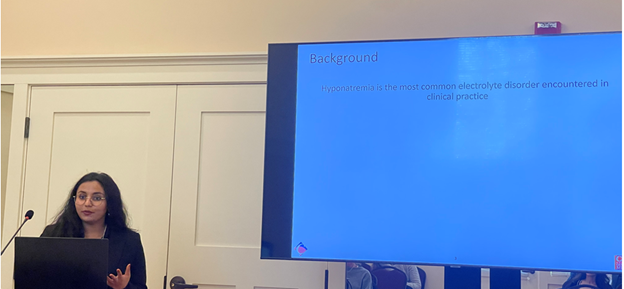
All authors: Ibarra, F., Garcia, M., Deshpande, S., Song, T., Hsu, J., Miglani, I., Jassal, A.
“Thank you, Dr. Ibarra, for putting this great team together and giving us the opportunity to immerse ourselves into an intellectual interest from start to finish. It was truly gratifying to pick a medically relevant project that piqued my curiosity, research the topic, contribute to the proposal design, comb through patient data, submit an abstract, and ultimately present our work to a live audience at the WRMC. I enjoyed collaborating with Johan, Roop, Anhadh, Marty, and TJ—colleagues I might not have otherwise had the chance to work with—and gaining firsthand insight into the meticulous effort required to refine a clinical study. Through this process, I experienced several firsts and for that, it will be a memorable part of my clinical training. I look forward to continuing the study and am hopeful that our proposal for managing severe hyponatremia will be implemented in Central Valley emergency rooms,” Shriya Deshpande
Evan Cheng, third-year medical student at CHSU-COM, delivered an oral presentation on his group’s project titled, “Comparison of two different fixed-dose factor eight inhibitor bypassing activity (FEIBA) regimens in the management of warfarin-associated coagulopathies.” This study found that the institutions’ new fixed, low-dose FEIBA regimen resulted in more patients achieving post-FEIBA INR goals compared to the old regimen. This study further supports the practice of administering low, fixed-doses versus large, standard-doses in the management of warfarin associated coagulopathies. This study additionally adds to the limited literature supporting the use of FEIBA in the management of warfarin associated bleeds.
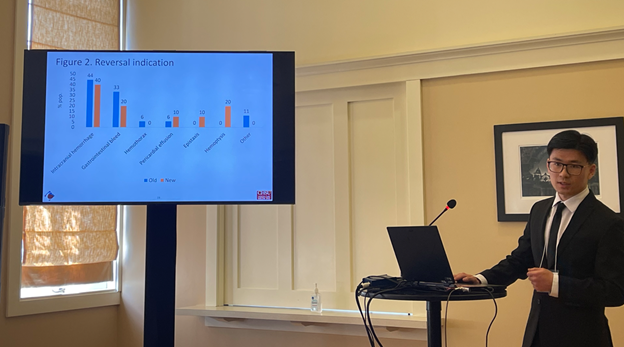
All authors: Ibarra, F., Mendoza, M., Cheng, E., Falkenstein, B.
“Attending and presenting at the Western Medical Research Conference, was an incredibly rewarding experience. It provided me the opportunity to share my research as well as learn from the projects of others. Practicing for my oral presentation also significantly helped me sharpen my communication skills and public speaking abilities, giving me greater confidence when presenting complex topics. Overall, it was a lot of fun and a great experience to learn from,” Evan Chang
Alexander Arzoo, third-year medical student at CHSU-COM, delivered an oral presentation on his group’s project titled, “Comparative effectiveness of three potassium exchangers in the acute management of hyperkalemia: sodium zirconium cyclosilicate, sodium polystyrene sulfonate, and patiromer.” This study found that when given in addition to standard of care, sodium zirconium cyclosilicate lowers potassium levels the most. Potassium binders are not routinely administered in the acute management of hyperkalemia due to their perceived delayed onset of action, but this study suggests potassium binders, specifically sodium zirconium cyclosilicate, should be given in the acute management of hyperkalemia along with standard of care to further reduce potassium levels.
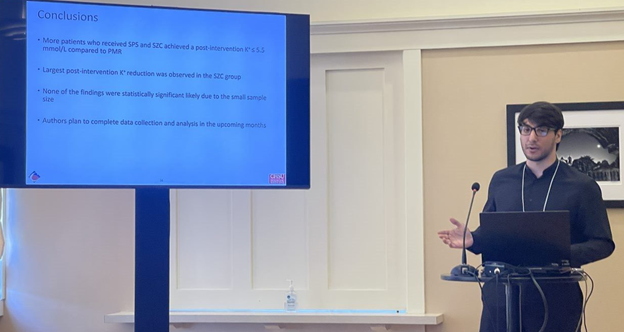
All authors: Ibarra, F., Fu, V., Mau, C., Rivera, D., Arzoo, A.
“I was honored to represent CHSU-COM and the efforts of my research group at this conference. It has always been a goal of mine to present a project in front of an audience of both my peers and the physicians I aspire to call colleagues in the future. Not only did the conference give me that opportunity, but it also taught me a great deal about various topical subjects in medicine. I feel that I have come out of this experience a more thorough researcher, a more compassionate team player, and a sharper orator. I cannot wait to present in the future,” Alexander Arzoo
Layla Mazdeyasnan, third-year medical student at CHSU-COM, delivered an oral presentation on her group’s project titled, “Pharmacological options for managing burning mouth syndrome.” Currently there is no standardized approach to managing burning mouth syndrome (BMS) and providers may be unaware of how to appropriately manage their patients. This study summarizes the pharmacological options available for managing BMS so providers may refer to it when managing patients with BMS.
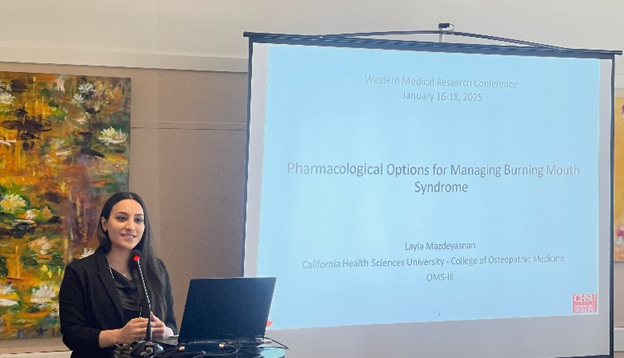
All authors: Mazdeyasnan, L., Shabbir, Z., Ibarra, F.
“Presenting my research orally at WMRC was a valuable experience. I had the opportunity to present in front of an engaged audience for the first time, which allowed me to showcase my work. This experience also deepened my understanding of the various research projects that students undertake from across the nation. This conference provided new insights and ideas that will help shape my future work.” Layla Mazdeyasnan
All research abstracts were published in the Journal of Investigative Medicine and can be found online.